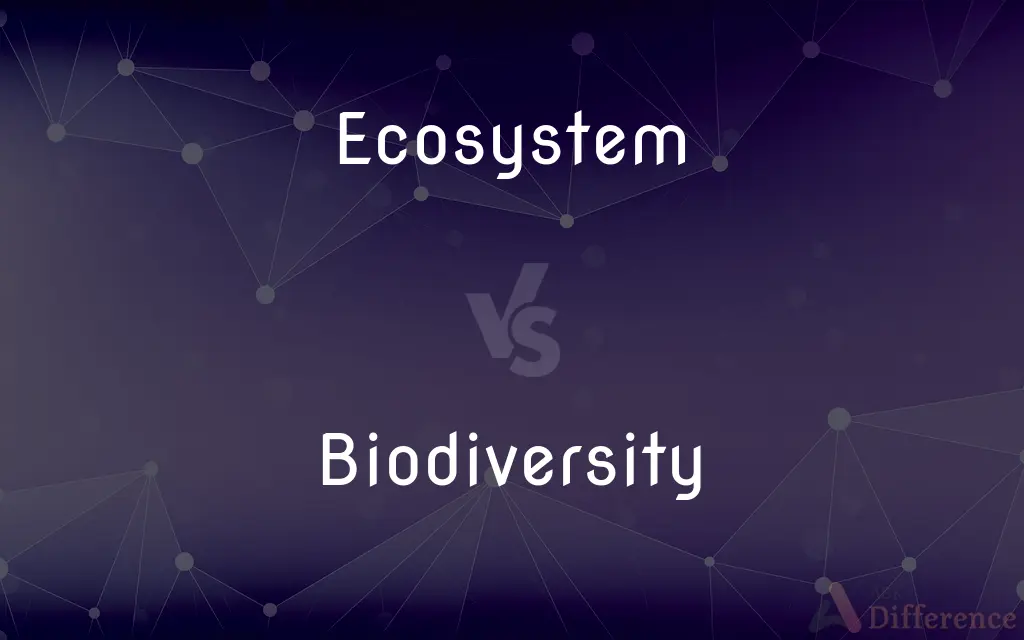Ecosystem vs. Biodiversity — What's the Difference?
Edited by Tayyaba Rehman — By Fiza Rafique — Updated on November 2, 2023
An ecosystem is a community of living organisms and their physical environment; biodiversity refers to the variety of life within any given ecosystem.

Difference Between Ecosystem and Biodiversity
Table of Contents
ADVERTISEMENT
Key Differences
An ecosystem is a complex network of living organisms (plants, animals, and microbes) interacting with each other and their physical environment (air, water, and soil). It's a functional unit where life processes are interlinked through nutrient cycles and energy flows.
Biodiversity, or biological diversity, is the variety of life forms within a given ecosystem, biome, or for the entire Earth. It is indicative of the health of an ecosystem. Greater biodiversity implies resilience against environmental changes and perturbations.
Ecosystems are the structural and functional units of ecology, encompassing the living (biotic) and non-living (abiotic) components of an environment. They range from small-scale like a pond to large-scale like a rainforest.
Biodiversity encompasses different levels including species diversity, genetic diversity, and ecosystem diversity. It's not just about the number of species but also the range of different life forms, from the genetic level to the variety of ecosystems.
The concept of an ecosystem includes the interactions between species as well as the flow of energy and materials. Every organism has a role, be it a predator, a prey, a decomposer, or a producer.
ADVERTISEMENT
Biodiversity, on the other hand, is a measure of the variation at the genetic, species, and ecosystem level. It reflects the number, variety, and variability of living organisms and how these change from one location to another and over time.
Comparison Chart
Definition
A community of living beings and their physical environment.
The variety of life within an ecosystem.
Focus
Interactions and flows of energy/materials.
Variety and variability of organisms.
Scale
Can be localized or expansive.
Considers multiple scales of life forms.
Components
Includes both biotic and abiotic elements.
Concerned with biotic elements only.
Measurement
Health assessed by stability and sustainability.
Measured by species richness and genetic diversity.
Compare with Definitions
Ecosystem
A biological community interacting with its environment.
The coral reef ecosystem is sensitive to water temperature changes.
Biodiversity
The variety of life in all its forms and levels of organization.
The biodiversity of the Great Barrier Reef includes over 1,500 fish species.
Ecosystem
A system formed by organisms and their habitat.
The Amazon rainforest is one of the most complex ecosystems on Earth.
Biodiversity
The abundance of different species living within a specific region.
National parks are often established to preserve biodiversity.
Ecosystem
The complex of a community and its environment functioning as a unit.
Preservation efforts focus on restoring the wetland ecosystem.
Biodiversity
A spectrum of species, genetic, and ecosystem variety.
Biodiversity ensures natural sustainability for all life forms.
Ecosystem
A network of interactions among organisms, and between organisms and their environment.
Urban ecosystems are increasingly affected by human activity.
Biodiversity
The variability among living organisms and ecological complexes.
Conservationists emphasize protecting biodiversity hotspots.
Ecosystem
A unit of nature where living organisms interact with each other and their surroundings.
Scientists study how pollution impacts freshwater ecosystems.
Biodiversity
The existence of many different kinds of plants and animals in an environment.
Tropical rainforests have some of the highest biodiversity on the planet.
Ecosystem
An ecosystem (or ecological system) consists of all the organisms and the physical environment with which they interact. These biotic and abiotic components are linked together through nutrient cycles and energy flows.
Biodiversity
Biodiversity is the biological variety and variability of life on Earth. Biodiversity is a measure of variation at the genetic, species, and ecosystem level.
Ecosystem
An ecological community together with its environment, functioning as a unit.
Biodiversity
The number and variety of species found within a specified geographic region.
Ecosystem
A system formed by an ecological community and its environment that functions as a unit.
Biodiversity
The variability among living organisms on the earth, including the variability within and between species and within and between ecosystems.
Ecosystem
The interconnectedness of organisms (plants, animals, microbes) with each other and their environment.
Biodiversity
(ecology) The diversity (number and variety of species) of plant and animal life within a region.
Ecosystem
(by extension) A network of interconnected people or organisations that resembles a natural ecosystem due to the complex interdependencies.
The company’s ecosystem mainly comprises its supply chain, customers, end consumers and competitors.
Biodiversity
The diversity of plant and animal life in a particular habitat (or in the world as a whole);
A high level of biodiversity is desirable
Ecosystem
A system formed by the interaction of a community of organisms with their physical environment
Common Curiosities
Why is biodiversity important to an ecosystem?
Biodiversity contributes to resilience and sustainability within an ecosystem.
Can an ecosystem have low biodiversity?
Yes, ecosystems like deserts may naturally have lower biodiversity.
How do human activities affect ecosystems?
They can alter habitats, reduce biodiversity, and disrupt ecological balance.
What is biodiversity?
Biodiversity is the variety and variability of life within an ecosystem.
How is the health of an ecosystem determined?
Through its productivity, stability, and ability to recover from disturbances.
Does biodiversity refer only to species?
No, it includes species, genetic, and ecosystem diversity.
What is an ecosystem?
An ecosystem is a community of living organisms and their physical environment interacting as a system.
Are all parts of an ecosystem equally important for biodiversity?
While all parts are important, some are critical for maintaining high levels of biodiversity.
Can biodiversity change within an ecosystem?
Yes, it can change due to natural and anthropogenic factors.
How can we protect biodiversity?
Through conservation efforts, habitat protection, and sustainable practices.
What is a simple example of an ecosystem?
A simple example is a garden with plants, insects, soil, and water.
Does the loss of one species affect ecosystem biodiversity?
Yes, it can disrupt ecological interactions and reduce overall biodiversity.
What role do keystone species play in ecosystems?
Keystone species have a disproportionate impact on ecosystem structure and function.
Is a city considered an ecosystem?
Yes, urban areas are complex ecosystems.
Can invasive species impact biodiversity?
Yes, invasive species can threaten native biodiversity and ecosystem health.
Share Your Discovery

Previous Comparison
Accomplish vs. Purpose
Next Comparison
Livener vs. DrinkAuthor Spotlight
Written by
Fiza RafiqueFiza Rafique is a skilled content writer at AskDifference.com, where she meticulously refines and enhances written pieces. Drawing from her vast editorial expertise, Fiza ensures clarity, accuracy, and precision in every article. Passionate about language, she continually seeks to elevate the quality of content for readers worldwide.
Edited by
Tayyaba RehmanTayyaba Rehman is a distinguished writer, currently serving as a primary contributor to askdifference.com. As a researcher in semantics and etymology, Tayyaba's passion for the complexity of languages and their distinctions has found a perfect home on the platform. Tayyaba delves into the intricacies of language, distinguishing between commonly confused words and phrases, thereby providing clarity for readers worldwide.















































